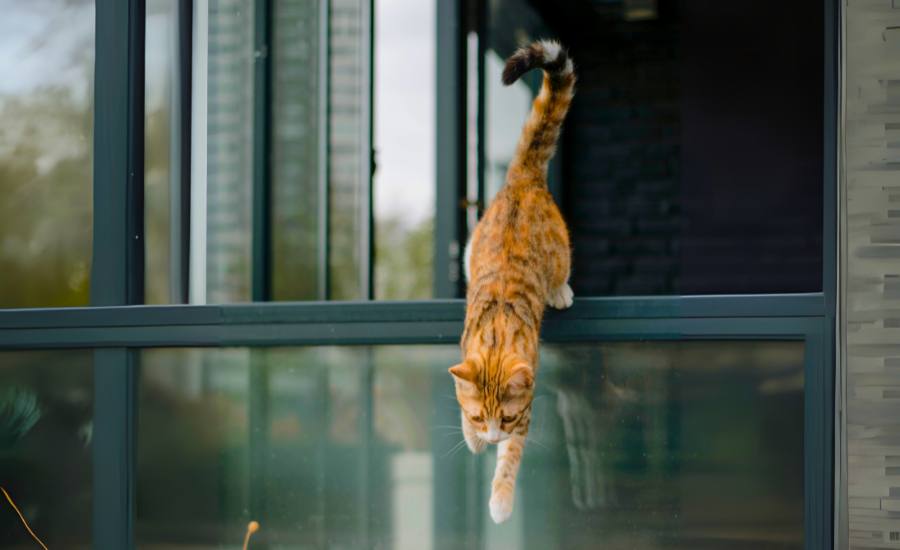Cat First Aid - How To Help Your Cat In An Emergency
Cats are adventurous creatures. They love to climb to precarious heights, investigate alluring things, and tease other pets. Their curious natures are something we love about our cats, but can get them into trouble, too.
Cats often sustain traumatic injuries as a result of their activities or environment. But, they are so adept at concealing pain that you may never have noticed (1). It is very difficult, even for vets, to assess the level of pain a cat is suffering (2).
Signs that your cat needs medical help could be small, such as a change in their toileting or eating habits, hiding away, or sleeping more often. They may constantly lick one area, or stop grooming altogether. You know your cat better than anyone, so don’t doubt yourself when you feel that something is off about their behaviour.
More obvious signs of pain include moving in an unusual way, such as limping or crawling. Your cat might suddenly refuse petting and play. They may hiss and cry, or become aggressive.
If you observe that your cat is suffering trauma, the first course of action is always to call the vet, even if they are closed. Veterinary practices always have on-call staff, who can advise you, and book emergency appointments out of hours.
In the meantime, you may need to know a thing or two about cat first aid, to support your feline friend until they receive professional help. Read on to discover how you can help your cat with cat first aid.
How To Clean A Cat Wound

It’s a good idea to check your cat over for wounds daily, while petting them. This contact will familiarise you with their healthy appearance, and help you bond with your cat too.
If you find a wound on your cat, you should call the vet, even if it seems small. This is because puncture wounds can seem tiny at skin level, but hide a deep-reaching injury and infection (3). After inspecting the wound, your vet may advise you to continue treating it at home.
Your vet will give you instructions and tell you how often to clean the wound during your visit. But, if you can’t get an emergency vet appointment, this is what you need to know.
Sterile gauze is by far the best material for wound cleaning. If gauze is not an option, use cotton pads. Soak the gauze in a cat-specific wound wash product or 0.9% saline solution. Using the soaked gauze, gently flush out the wound by allowing the wound wash to flow over it. Then, carefully wipe the wound clean (3).
You are limited as to what you can put on a cat wound after cleaning. Many human and dog medicines are poisonous to cats, as their livers can’t process the same toxins (4). Iodine is safe for cats, but only as 1% povidone-iodine dilution, and only applied topically (not ingested). You can’t use Savlon on cats and it is a dangerous idea to apply any similar household medicines.
Our advice is to only put cat-specific medical products on the wound after cleaning. Your vet may prescribe a cat-safe antibiotic ointment following your visit.
Controlling Bleeding
The most common cause of bleeding in cats are wounds to the paws and claws. To control a bleeding cat wound, use non-stick wound pads and bandages. If you don’t have these, use freshly-washed white fabric like a tea towel or bed sheet.
Place a wound pad on the injury, cover with the material or bandage and apply constant pressure. Don’t attempt to apply a tourniquet above the wound, as this is likely to do more damage. Don’t lift the material to check the wound, as you could dislodge a clot and cause further bleeding. The white fabric will show how much blood is being lost (3).
Get your cat to the vet as soon as possible, where they will be able to treat and dress your cat's wound to control the bleeding.
Related post: What have you always wanted to ask a vet?
Treating Cat Fight Wounds
Cats often get cat fight wounds from other kitties. Bites and scratches cause particularly dangerous wounds, as they introduce a lot of bacteria. Bacteria cause infections and sepsis. Cat fight wounds are also likely to be puncture wounds, which can look superficial but hide deeper trauma.
Always have cat fight wounds checked by the vet. In the meantime, you should manage and clean the wound as described above.
How To Help A Choking Cat
Cat choking is not very common. Signs that your cat could be choking include wheezing, gasping for breath, panic, or simply chronic coughing (5).
If your cat is choking, get to the vet as soon as possible. In the meantime, you should provide cat first aid to help your kitty breathe. Don’t be tempted to tilt your cat’s head up and open its mouth to look inside. This may cause them to swallow the item further, and constrict the airways.
Instead, you should get someone to help by holding the cat on a surface such as a table. They may need to wrap the cat in a towel to protect themselves. You should get lower than the cat, and open their mouths to look inside. You may see a foreign object lodged at the back of the mouth. You can try to gently remove this with blunt tweezers, but don’t force it. Don’t pull on any string-like object, as it is likely to extend further into the cat’s body.
Help to keep your cat calm and breathing as easily as possible by supporting them in a sphinx-like position, laying on their belly with legs tucked under. They should have their legs engaged, with their front paws outstretched. This position straightens their airways.
As a very last resort, in an emergency where your cat’s airways are completely blocked, you could try the Heimlich manoeuvre. Don’t do this unless absolutely necessary, as the Heimlich manoeuvre may break ribs or cause internal injuries. Lay the cat on its side. Put one hand along their spine for support. Place the other hand on the belly, just below the ribcage. Give several sharp thrusts inward and upward (6). Then, return the cat to the previous position to promote breathing.
Cat CPR
Learning how to do CPR on a cat takes years of practice. Cardiopulmonary resuscitation (CPR) is very risky. It is likely to break rib bones, puncture lungs or cause other internal damage (7). We don’t recommend that you attempt cat CPR.
If your cat is not breathing or has no heartbeat, get to your vet as soon as possible. The vet will be able to intubate them to help them breathe and stimulate their heartbeat with medication. Until then, you can support your cat by putting them in the sphinx-like body position on a flat surface as described above. Cuddling or carrying them will restrict the movement of their ribcage.
What To Include In A Cat First Aid Kit

It is a great idea to plan for mishaps by building a cat first aid kit. Your cat first aid kit should include sterile gauze, non-stick wound pads and sterile badges to manage bleeding and wounds. We recommend purchasing 0.9% saline or cat-specific wound wash for flushing wounds.
You could also buy 1% povidone-iodine or cat-safe antibacterial ointment for your cat first aid kit. These can be applied to wounds after cleaning. You can’t use Savlon on cats. Many common antibacterial ointments such as witch hazel, hydrogen peroxide, and tea tree oil are not safe for cats.
Other excellent items for your cat first aid kit include veterinary blood-clotting powder, blunt-tipped tweezers, and a pre-prepared clean white towel.
Related post: How to keep your cat happy outside
First Aid For Bites And Stings

If your cat has a bite or sting, the first thing to do is check the environment around your cat. Can you see the insect or small animal? Are you in danger yourself? Try to identify what has stung or bitten your cat, as this information could be important later on.
Then you need to inspect the bite or sting wound. If the wound is in the eyes, mouth, nose or throat, you need to go to the vet immediately. There could be swelling that may cause breathing difficulties for your cat.
Is there a stinger or mouthpiece left in the wound? If so, try to gently remove it using clean tweezers. If you can't, then the vet could do it for you. Be careful not to squeeze the area, as you could accidentally release more toxins into the wound.
Next, you should clean the bite or sting in the same way as other wounds described above. Most bites and stings are nothing to worry about. However, it is a good idea to keep your cat under close observation for the next few hours. If your kitty has an allergic reaction such as swelling or breathing difficulties, you will need to visit the vet.
First Aid For Burns And Scalds
Cat burns and scalds are not very common, but can occur in the kitchen, or when cats shelter in the warm parts of parked cars. Burns and scalds need different cat first aid than other wounds. They can continue to develop in severity after the initial contact with heat.
The best thing to do is pour clean, cool water or 0.9% saline continuously over the injury, while someone calls the vet. Don’t touch the injury as it is easy to cause further damage. Then, soak a clean wound-pad, bandage, or even bed sheet in cool water or saline and cover the burn or scald. This will act as a protective skin from now on (8).
Once the wet fabric is applied to the wound, don’t lift it again, as you could accidentally pull away burned skin or hair. Instead, you can continue to pour fresh cool water over the covering, while it is in place. Your aim is to draw heat out from the wound, while preventing further damage and stopping bacteria from entering. Following your quick-thinking cat first aid, the vet will provide professional medical care to heal your kitty.
References
- Taylor, P. M., & Robertson, S. A. (2004). Pain management in cats—past, present and future. Part 1. The cat is unique. In Journal of Feline Medicine and Surgery (Vol. 6, Issue 5, pp. 313–320). SAGE Publications. https://doi.org/10.1016/j.jfms.2003.10.003
- Wright, B. D. (2002). Clinical pain management techniques for cats. In Clinical Techniques in Small Animal Practice (Vol. 17, Issue 4, pp. 151–157). Elsevier BV. https://doi.org/10.1053/svms.2002.36609
- VCA Animal Hospitals (2022). Care Of Open Wounds In Cats | VCA Animal Hospitals. [online] Available at: https://vcahospitals.com/know-your-pet/care-of-open-wounds-in-cats. [Accessed 12 Feb. 2022].
- Schmid, R., Brutlag, A. & Ward, E. (2020). Household hazards - toxic hazards for cats. Available from: https://vcahospitals.com/know-your-pet/household-hazards-toxic-hazards-for-cats
- Levitt, L., Clark, G. R., & Adams, V. (1993). Tracheal foreign body in a cat. The Canadian veterinary journal = La revue veterinaire canadienne, 34(3), 172–173.
- Pet M.D. (2010). Choking and the Heimlich Manouevre in cats. Available from: https://www.petmd.com/cat/emergency/common-emergencies/e_ct_choking_and_heimlich_maneuver
- PetMD Editorial (2020). CPR for Cats and Kittens. [online] Petmd.com. Available at: https://www.petmd.com/cat/emergency/common-emergencies/e_ct_respiration_cpr. [Accessed 12 Feb. 2022].
- Pet M.D.(2010). Burns and Scalds in Cats. Available from: https://www.petmd.com/cat/emergency/accidents-injuries/e_ct_burns







